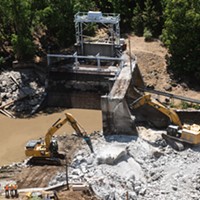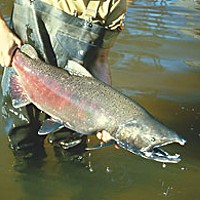Klamath Spring Chinook Receive New State Protections
By Kimberly Wear [email protected] @kimberly_wear[
{
"name": "Top Stories Video Pair",
"insertPoint": "7",
"component": "17087298",
"parentWrapperClass": "fdn-ads-inline-content-block",
"requiredCountToDisplay": "1"
}
]
A decades-long effort to protect spring Chinook took a major step forward last week when the California Fish and Game Commission unanimously approved listing the fish as threatened under the state’s Endangered Species Act.
The June 16 decision was applauded by Karuk Tribe and Salmon River Restoration Council, which jointly filed a petition to list Upper Klamath-Trinity River spring Chinook with the commission in August of 2018, buoyed by new research that showed the so-call “springers” are genetically distinct from their fall counterparts.
“We are elated that the commission recognized the unique characteristics, cultural importance and true peril of Klamath River Spring Chinook,” said Salmon River Restoration Council (SRRC) director Karuna Greenberg. “Tribes and grassroots activists have worked tirelessly for decades to preserve this iconic fish, and now we have a better chance at accomplishing that goal.”
Playing an important role in the research that helped lead to the listing were a cache of spring Chinook bones — some dating back 5,000 years — left inside Upper Klamath Basin caves used by tribal fishermen for untold generations.
(Read more about how the discovery of the ancient DNA and new technology help rewrite the life story of spring Chinook in the Journal story, “One Fish, Two Fish” from Aug. 16, 2017).
The findings, as Karuk Chair Russell ‘Buster’ Attebery noted in a news release about the commission's listing of the springers, only corroborate what Native American tribes that have lived in the Klamath basin for millennia have always known.
"These fish have different names, are used in different ceremonial events, they even taste different. I’m pleased to see western science finally catching up to traditional ecological knowledge,” Attebery said.
Another important step for saving the fish, which once number in the hundreds of thosands but now teeters on the brink of extinction, will be the removal of the four dams on the Klamath River, which will allow the spring run to return to the cool, upper basin pools of their historic range for the first time in a century.
That project, the largest of its kind in U.S. history, is slated to begin in 2023 after hitting a major milestone as well last week, with the Federal Energy Regulatory, approving a transfer of the hydroelectric license from PacifiCorp to the nonprofit Klamath River Renewal Corporation and the states of Oregon and California.
And, for the springers, the removal can't come fast enough.
Surveys done in recent years have "counted only a couple hundred individuals in the Salmon River, which hosts the last viable wild run of these fish in the Klamath Basin," according to the news release.
Read the June 17 news release from the Karuk Tribe and the Salmon River Restoration Council below:
Another important step for saving the fish, which once number in the hundreds of thosands but now teeters on the brink of extinction, will be the removal of the four dams on the Klamath River, which will allow the spring run to return to the cool, upper basin pools of their historic range for the first time in a century.
That project, the largest of its kind in U.S. history, is slated to begin in 2023 after hitting a major milestone as well last week, with the Federal Energy Regulatory, approving a transfer of the hydroelectric license from PacifiCorp to the nonprofit Klamath River Renewal Corporation and the states of Oregon and California.
And, for the springers, the removal can't come fast enough.
Surveys done in recent years have "counted only a couple hundred individuals in the Salmon River, which hosts the last viable wild run of these fish in the Klamath Basin," according to the news release.
“We thank the commissioners for listening to the Tribe’s concerns and traditional knowledge in their decision to accept our petition. California is on the right track when it comes to working with Tribes,” said Karuk traditional dip net fishermen and council member Troy Hockaday.
Sacramento, CA – Today the California Fish and Game Commission ruled unanimously to add Upper Klamath Trinity Spring Chinook to the California Endangered Species List.
“We are elated that the Commission recognized the unique characteristics, cultural importance and true peril of Klamath River Spring Chinook.,” said Salmon River Restoration Council (SRRC) director Karuna Greenberg. “Tribes and grassroots activists have worked tirelessly for decades to preserve this iconic fish, and now we have a better chance at accomplishing that goal.”
The Karuk Tribe and SRRC jointly filed a petition to list Spring Chinook with the Commission in August 2018. The petition is based on the discovery of the genetic sequence that defines Spring Chinook as distinct from the more abundant Fall Chinook.
That data was published in 2017 by UC Davis Professor Michael Miller and colleagues. Adding Spring Chinook to the CA Endangered Species List will allow agencies to prioritize funding for restoration and ensure any projects in the fish’s range will have to avoid adverse impacts to the population.
Spring Chinook enter rivers in the spring when snow melt swells rivers allowing the fish to travel into the upper reaches of a watershed. Then they must reside in cold water areas all summer until they spawn and die in the fall. Fall Chinook migrate into rivers in the fall where they spawn and die relatively soon after entering fresh water.
“Having two life strategies allow Chinook to take advantage of the entire watershed instead of just the upper or lower reaches,” explains Toz Soto, Senior Fisheries Biologist for the Karuk Tribe. “This behavioral diversity enhances the odds for long-term survival for the entire population.”
However, until Miller published his findings, the conventional wisdom of fisheries managers was that Fall and Spring Chinook were the same animal despite the differences in behavior. It was not until new scientific instruments and methods were developed that scientists could find the small but very significant changes in DNA sequence that result in the two fish having fundamentally different life histories.
The Karuk and other tribes that have depended on Spring Chinook for sustenance for millennia already knew the two fish were not the same animal.
“These fish have different names, are used in different ceremonial events, they even taste different. I’m pleased to see western science finally catching up to traditional ecological knowledge,” noted Karuk Chairman Russell ‘Buster’ Attebery.
The population of Chinook salmon that swims up the Klamath River in the spring once numbered in the hundreds of thousands. In recent years, surveyors at the Salmon River Cooperative Spring Chinook and Summer Steelhead Population Snorkel Survey have counted only a couple hundred individuals in the Salmon River, which hosts the last viable wild run of these fish in the Klamath Basin.
“We thank the Commissioners for listening to the Tribe’s concerns and traditional knowledge in their decision to accept our petition. California is on the right track when it comes to working with Tribes,” noted Karuk traditional dip net fishermen and council member Troy Hockaday.
Spring Chinook advocates currently have January 2023 circled on their calendars. That’s when the removal of the lower four Klamath River dams is slated to begin pursuant to an historic agreement between dam owner PacifiCorp, California, Oregon, Tribes, and conservation groups. The project would be the largest salmon restoration project in US history. For Spring Chinook and the Karuk Tribe, it can’t come soon enough. The National Marine Fisheries Service is currently considering a similar petition from Karuk and SRRC to list on the federal ESA.
Speaking of...
more from the author
-
Dust to Dust
The green burial movement looks to set down roots in Humboldt County
- Apr 11, 2024
-
Our Last Best Chance
- Apr 11, 2024
-
Judge Rules Arcata Can't Put Earth Flag on Top
- Apr 5, 2024
- More »


































